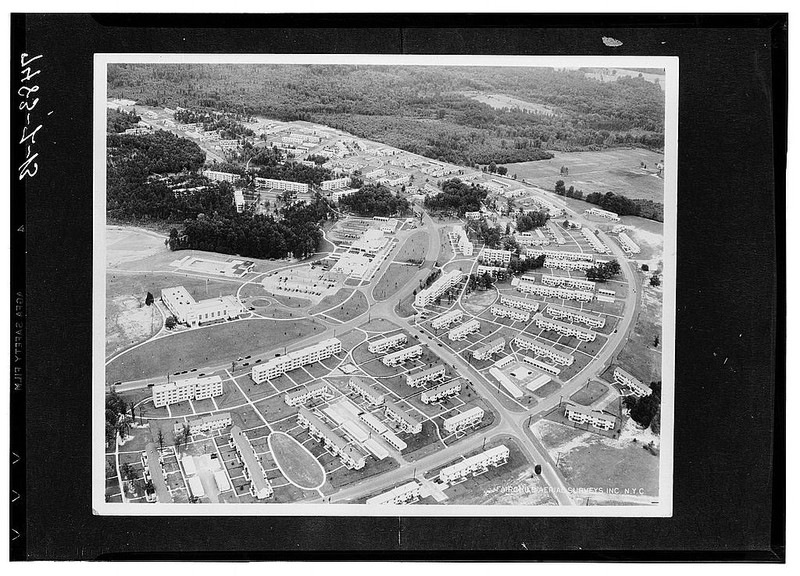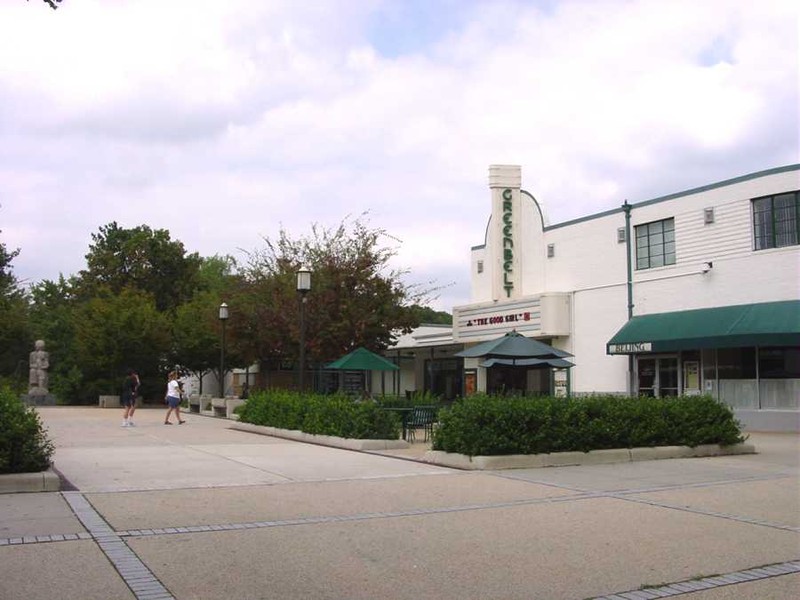Greenbelt Historic District
Introduction
Text-to-speech Audio
Images
Aerial view of Greenbelt by Fairchild Aerial Survey, 1939. Courtesy of theLibrary of Congress (public domain)

Old Greenbelt Theatre by Jessica Falkinburg, 2003 (reproduced under Fair Use)

Backstory and Context
Text-to-speech Audio
The Resettlement Administration under Rexford Guy Tugwell, developed Greenbelt on forest and tobacco fields outside of Washington, DC between 1935 and 1938. The aim of this planned community was to create jobs and low-income housing, as well as to put into action philosophies of cooperative and self-sufficient living. Tugwell believed in the importance of park and green space accessibility, and so the city was constructed with a "belt" of forest around it, and it includes a manmade lake. City planners designed the city in a crescent shape according to the natural topography of the area.
The project was not without its detractors. A federally-planned city seemed radical or socialistic to critics. Tugwell and Resettlement Administration researchers investigated factors that led to prosperous communities. Individuals interested in moving to Greenbelt had to apply and include medical history and references. African-Americans were originally excluded from applying.
Greenbelt was the first community in Maryland to adopt the council-manager form of government. Maryland granted it a charter in June 1937, with residents moving in three months later.
Hale Walker, Harold Bursley, and Reginald Wadsworth were the chief designers of the city. Art Deco, "New Tradition"/International Style, and Bauhaus architecture are the most prominent styles in the city. Most of the buildings are concrete or brick veneer. At the center of the development is a town common and one of the first planned shopping centers in the country. Houses faced shared yards, and pedestrian and car traffic were separate to create a safer environment, especially for children.
During World War II, the federal government built an additional 1000 houses in Greenbelt to house defense workers. A cooperative named Greenbelt Homes, Inc. bought much of the city from the U.S. government. From the initial population of 3,000 in 1937, the city's residents and boundaries have expanded to 24,000 in 2018. In the 1960s, Greenbelt served as an inspiration for additional planned cities in Reston, Virginia and Columbia, Maryland.
Greenbelt was the first of the planned "Green cities" planned in this way, the others being Greendale, Wisconsin and Greenhills, Ohio. A fourth planned city in New Jersey was never constructed. Greenbelt's sister cities have undergone more significant changes, but Greenbelt's intact historical features have led to its recognition by the National Register of Historic Places and as a National Historic Landmark. The entire city exhibits historical significance, and the Greenbelt Museum is open on Sunday afternoons.
Sources
Carter, Elliot. Greenbelt Historic District, Atlas Obscura. Accessed July 19th 2020. https://www.atlasobscura.com/places/greenbelt-historical-district.
Hauenstein, Thomas. Greenbelt Historic District, National Register of Historic Places Inventory -- Nomination Form. November 1979. Accessed July 19th 2020. https://mht.maryland.gov/secure/medusa/PDF/NR_PDFs/NR-656.pdf.
National Park Service. Greenbelt Historic District, National Park Service: Places. July 2nd 2018. Accessed July 19th 2020. https://www.nps.gov/places/greenbelt-historic-district.htm.
https://www.loc.gov/item/2017761898/
https://mht.maryland.gov/nr/NRDetail.aspx?NRID=658
